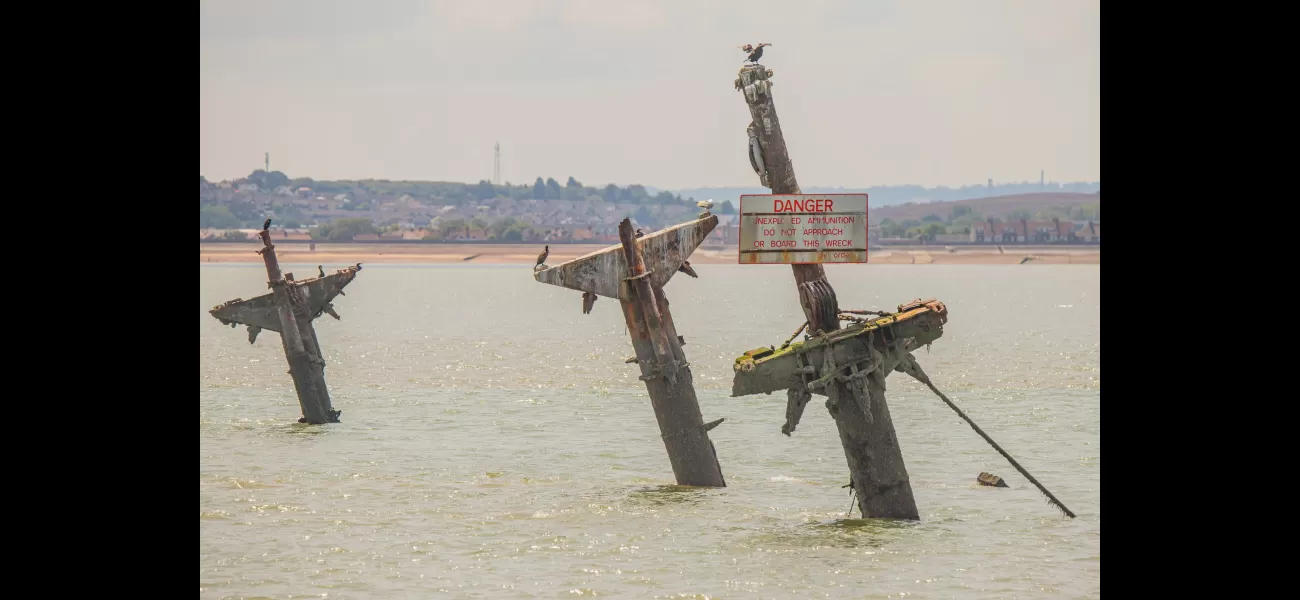Experts warn that a ship loaded with explosives in the Thames is at risk of detonation.
Since 1944, the SS Montgomery has been underwater in the Thames Estuary, carrying 1,400 tonnes of explosives.
January 24th 2024.

There is a looming danger in the River Thames, as a World War II battleship, the SS Richard Montgomery, remains submerged with 1,400 tonnes of unexploded bombs on board. The ship has been a part of the river's landscape for over seven decades, earning the nickname 'Doomsday Wreck.' However, experts now fear that the corroded vessel could explode at any moment, causing catastrophic destruction.
The Montgomery, named after the American General Richard Montgomery, was originally built to transport supplies to Allies during the war. In 1944, it set sail from America carrying 7,000 tonnes of explosives and eventually arrived in the UK. But due to a force 8 gale, the ship's anchor dragged into shallow waters, causing it to collide with a bank and break in half. It has since remained at the bottom of the river, with its three masts still visible above the surface.
Over the years, the Montgomery has become an unusual tourist attraction, drawing in curious onlookers to see its masts and learn about its history. However, as time passed, the ship's structural integrity has deteriorated, raising concerns that the masts could collapse onto the explosives and trigger a massive blast. This possibility has led to a parliamentary report from Medway Council, stating that the blast could potentially create a 1,000ft column of water, mud, metal, and munitions, reaching heights of 10,000ft and endangering lives and wildlife.
The potential explosion could also result in a massive tsunami, causing widespread destruction and death. According to researchers at Defence Research and Development Canada, the Montgomery has the potential to create one of the largest non-nuclear explosions in the world. This has sparked urgency among local officials, such as Southend Labour councillor Lydia Hyde, who believes that action needs to be taken immediately to prevent a catastrophic incident.
The ship's corroded masts have been a cause for concern, and plans to remove them have been in place since 2020. However, the work has been delayed for years, and they still stand today. In a recent assessment, experts found that the corrosion was more severe than expected, prompting them to move the removal date forward. Councillor Hyde explains that the metal has been rusting over time, and now, the safest option is to remove the masts before they collapse and ignite the explosives. The removal is scheduled for March, and the Department for Transport assures that they are taking necessary precautions to ensure the safety of the public.
The potential explosion has been a topic of discussion for many years, with various assessments done to determine the risk and possible impact. A 1970 assessment by the Royal Military College of Science stated that the blast could reach heights of 3,000 meters and create a five-meter-high tsunami, overwhelming nearby towns like Sheerness and the Isle of Grain. However, Councillor Hyde believes that the impact would also be felt in Southend, causing windows to blow out and potentially endangering pedestrians. The Isle of Sheppey, which is only two miles away from the wreck, would also be significantly affected.
The Department for Transport acknowledges the risk posed by the SS Richard Montgomery and is committed to removing the masts as soon as possible. They have commissioned experts to conduct surveys and are reviewing and updating their plans accordingly. While there are concerns about the potential explosion, the government is taking necessary measures to ensure the safety of the public and minimize the risk.
The Montgomery, named after the American General Richard Montgomery, was originally built to transport supplies to Allies during the war. In 1944, it set sail from America carrying 7,000 tonnes of explosives and eventually arrived in the UK. But due to a force 8 gale, the ship's anchor dragged into shallow waters, causing it to collide with a bank and break in half. It has since remained at the bottom of the river, with its three masts still visible above the surface.
Over the years, the Montgomery has become an unusual tourist attraction, drawing in curious onlookers to see its masts and learn about its history. However, as time passed, the ship's structural integrity has deteriorated, raising concerns that the masts could collapse onto the explosives and trigger a massive blast. This possibility has led to a parliamentary report from Medway Council, stating that the blast could potentially create a 1,000ft column of water, mud, metal, and munitions, reaching heights of 10,000ft and endangering lives and wildlife.
The potential explosion could also result in a massive tsunami, causing widespread destruction and death. According to researchers at Defence Research and Development Canada, the Montgomery has the potential to create one of the largest non-nuclear explosions in the world. This has sparked urgency among local officials, such as Southend Labour councillor Lydia Hyde, who believes that action needs to be taken immediately to prevent a catastrophic incident.
The ship's corroded masts have been a cause for concern, and plans to remove them have been in place since 2020. However, the work has been delayed for years, and they still stand today. In a recent assessment, experts found that the corrosion was more severe than expected, prompting them to move the removal date forward. Councillor Hyde explains that the metal has been rusting over time, and now, the safest option is to remove the masts before they collapse and ignite the explosives. The removal is scheduled for March, and the Department for Transport assures that they are taking necessary precautions to ensure the safety of the public.
The potential explosion has been a topic of discussion for many years, with various assessments done to determine the risk and possible impact. A 1970 assessment by the Royal Military College of Science stated that the blast could reach heights of 3,000 meters and create a five-meter-high tsunami, overwhelming nearby towns like Sheerness and the Isle of Grain. However, Councillor Hyde believes that the impact would also be felt in Southend, causing windows to blow out and potentially endangering pedestrians. The Isle of Sheppey, which is only two miles away from the wreck, would also be significantly affected.
The Department for Transport acknowledges the risk posed by the SS Richard Montgomery and is committed to removing the masts as soon as possible. They have commissioned experts to conduct surveys and are reviewing and updating their plans accordingly. While there are concerns about the potential explosion, the government is taking necessary measures to ensure the safety of the public and minimize the risk.
[This article has been trending online recently and has been generated with AI. Your feed is customized.]
[Generative AI is experimental.]
0
0
Submit Comment





